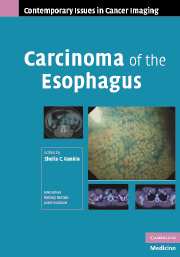Book contents
- Frontmatter
- Contents
- Contributors
- Series foreword
- Preface to Carcinoma of the Esophagus
- 1 Epidemiology and Clinical Presentation in Esophageal Cancer
- 2 Pathology of Esophageal Cancer
- 3 Recent Advances in the Endoscopic Diagnosis of Esophageal Cancer
- 4 Endoscopic Ultrasound in Esophageal Cancer
- 5 CT in Esophageal Cancer
- 6 FDG-PET and PET/CT in Esophageal Cancer
- 7 The Role of Surgery in the Management of Esophageal Cancer and Palliation of Inoperable Disease
- 8 Chemotherapy and Radiotherapy in Esophageal Cancer
- 9 Role of Stents in the Management of Esophageal Cancer
- 10 Lasers in Esophageal Cancer
- Index
- References
9 - Role of Stents in the Management of Esophageal Cancer
Published online by Cambridge University Press: 08 August 2009
- Frontmatter
- Contents
- Contributors
- Series foreword
- Preface to Carcinoma of the Esophagus
- 1 Epidemiology and Clinical Presentation in Esophageal Cancer
- 2 Pathology of Esophageal Cancer
- 3 Recent Advances in the Endoscopic Diagnosis of Esophageal Cancer
- 4 Endoscopic Ultrasound in Esophageal Cancer
- 5 CT in Esophageal Cancer
- 6 FDG-PET and PET/CT in Esophageal Cancer
- 7 The Role of Surgery in the Management of Esophageal Cancer and Palliation of Inoperable Disease
- 8 Chemotherapy and Radiotherapy in Esophageal Cancer
- 9 Role of Stents in the Management of Esophageal Cancer
- 10 Lasers in Esophageal Cancer
- Index
- References
Summary
Introduction
Esophageal cancer is the sixth leading cause of death from malignant disease worldwide. Patients may have no symptoms until the diameter of the esophageal lumen has been reduced by 50%, resulting in late presentation and poor prognosis. Esophageal neoplasms are associated with a poor outcome, with an overall 5-year survival rate of less than 10%. Fewer than 50% of patients are suitable for resection at presentation, and palliation is the best option for those with irresectable lesions.
Esophageal stents for palliation
The aims of palliative treatment are maintenance of oral intake, minimizing hospital stay, relief of pain, elimination of reflux and regurgitation, and prevention of aspiration. Current methods of palliation include thermal ablation, photodynamic therapy, radiotherapy, chemotherapy, chemical injection therapy, argon beam or bipolar electrocoagulation therapy, enteral feeding (nasogastric tube/percutaneous endoscopic gastrostomy), and intubation with self-expanding metal stents (SEMS) or semirigid prosthetic tubes.
Endoluminal esophageal prostheses have been in use for over a century. A variety of tubes inserted using pulsion or traction have been described. Leroy d'Etiolles made the earliest device in 1845 of decalcified ivory, followed by Charters J. Symonds who introduced the first metal esophageal prosthesis in 1885. Esophageal stenting using SEMS is the commonest modern means of palliation and is associated with high success rates and relatively few complications.
- Type
- Chapter
- Information
- Carcinoma of the Esophagus , pp. 134 - 144Publisher: Cambridge University PressPrint publication year: 2007

